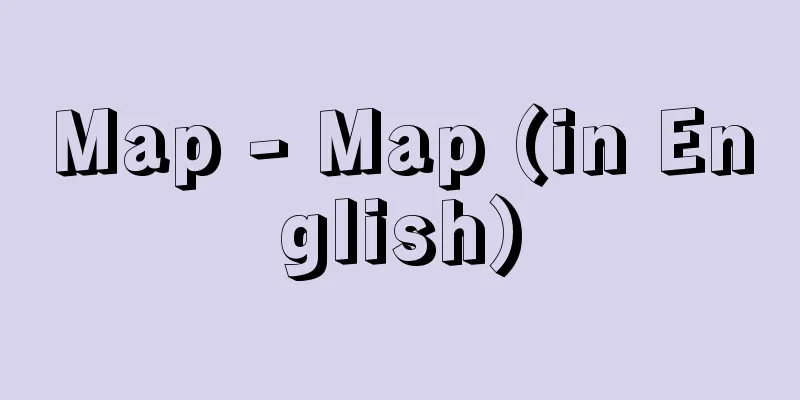Map - Map (in English)

|
A map is a representation of the state of all or part of the Earth's surface, generally on a flat surface, using symbols and letters, and reduced in size. Maps are an excellent means of conveying information about land that is distributed in a complex manner, and are indispensable for our activities and daily life, including various surveys, planning, administration, education, and recreation. [Gojo Eiji] Map ElementsThere are three common elements that make up a map: scale, map projection, and symbol. [Gojo Eiji] ScaleThe scale is the ratio of the length (distance) to the actual ground, and is usually expressed as a fraction or ratio with a numerator of 1. The larger the fraction (the smaller the denominator), the larger the scale. The scale is determined by the size of the area to be covered and the purpose of the map. In Japan, a scale of 1:1 to 2:1 is appropriate for a map that shows the entire country, around 1:500,000 for a region such as Tohoku or Kyushu, and around 1:200,000 for an area of about one prefecture. To see very fine details, a scale of 1:50,000 or 1:25,000 is appropriate, and to distinguish even in meters, a scale of at least 1:5,000 is required. On the other hand, for a map of a continent or the world, the scale is extremely small, at 1:1 to tens of millions. As you can see, there are many different scales. [Gojo Eiji] Map projectionsMap projection, map projection method, or projection in relation to a map refers to the method of drawing from the curved surface of the Earth's surface onto the curved surface of the map (usually flat, sometimes with intermediate shapes such as a cylinder or cone) that is the projection surface, and the mathematical theory behind it. Each individual map projection is called a projection. The meridians and parallel circles on Earth are called meridians and parallels on a map. Among meridians, the one that is represented by a straight line and serves as the vertical axis in a drawing using coordinate values is called the central meridian or central meridian. The latitude or meridian that correctly represents distance at the scale of the map and plays a fundamental role in the construction of a projection is called the standard parallel or standard meridian. When the shape of the Earth is represented on a flat map, distortion occurs due to the expansion and contraction of the projection surface caused by the projection. The content of distortion is quantified into length (distance), area, and direction angle (angle) according to the nature of the projection in map use. Map projections are classified according to the nature of the projection into (1) equidistant projections (which accurately represent the length of a specific line without distortion), (2) equal-area projections (which accurately represent any area without distortion), (3) conformal projections (which accurately represent angles in any direction within a small range without distortion), and (4) others. In all projections, when the projection axis (the axis of the curved surface in a cylinder or cone, or the straight line perpendicular to it in a plane) is perpendicular to the Earth's axis, it is called the horizontal axis (normal) or equatorial axis (normal), and when it is oblique, it is called the oblique axis (normal) or horizon (normal). When both axes coincide, that is, the true normal axis (normal) or polar axis (normal), this is not necessarily included in the name of the projection. Based on the projection surface, they are divided into (1) azimuthal projections (projection surface is flat), (2) conic projections (projection surface is conical), and (3) cylindrical projections (projection surface is cylindrical). Conic projections and cylindrical projections can be thought of as developing a cone or cylinder, so they are collectively called development projections. According to the method of projection, they are classified as projections and convention projections. Among convention projections, in addition to the fact that the parallels become concentric circles (azimuthal projections), concentric arcs (conic projections), or parallel straight lines (cylindrical projections) when the axis is normal, the meridians other than the central meridian are changed from straight lines to curved lines, and there are (1) pseudoazimuthal projections, (2) pseudoconic projections, and (3) pseudocylindrical projections. A world map whose outer meridians are ellipses is called an elliptical projection (or oval projection). [Kanazawa Takashi] Historical transitions: ancient timesIn ancient Greece, located on the western side of the Eurasian continent, Thales invented the gnomonic projection in the 5th century BCE, Apollonius invented the orthographic projection around 240 BCE, and Hipparchus invented the stereographic projection in the latter half of the 2nd century BCE, and they were used for sundial scales and star charts. In addition to the famous historical fact that Apollonius' contemporary Eratosthenes measured the circumference of the Earth as a sphere, he also described a method of mapping the Mediterranean world based on a network of coordinate lines, with the horizontal axis connecting the Strait of Gibraltar and the island of Rhodes, and the vertical axis connecting Syene (present-day Aswan) in the middle of the Nile River and Alexandria, as recorded in Strabo's Geography, written around 5 BCE. According to later estimated maps, this map is thought to have used an equirectangular projection. And to indicate latitude, klimata, an ancient name for a climate zone based on the difference in the amount of sunlight in each region, was used. [Kanazawa Takashi] Before the 15th centuryThe equidistant cylindrical projection was invented by Marinus of Tyre in the 1st century AD, and is introduced in the 2nd century Ptolemy's Geography as the Marino projection. In addition, the following two projections were described as alternatives to this projection, which are more suitable for showing the relative distances of the entire spherical world and the roundness of the sphere. The first is the equidistant conic projection (Ptolemy projection) of the northern hemisphere, and the Ptolemy I projection, which is similar to a conic projection in which the southern part is folded back from the equator, and the other is the Ptolemy II projection, which is considered to be the prototype of the Bonne projection. In addition, the Ptolemy III projection, which is an oblique exocentric projection to show the three-dimensional relationship between the Earth and the celestial sphere surrounding it, was also described. For regional maps, the use of an equidistant cylindrical projection (possibly a Marino projection) is mentioned, and the regional maps in the atlas of the 13th-century manuscript of Ptolemy's Geographies (the oldest surviving copy) are based on this method, but the regional maps in the 15th-century manuscripts include an isosceles trapezoidal polyhedral projection and an equidistant conic projection. In the eastern part of the Eurasian continent, Zhang Heng, a contemporary of Ptolemy in China, used a grid map (equidistant cylindrical projection), a coordinate system with evenly spaced grid lines, for land surveys. In the 3rd century, Fei Xiu created a map of the areas of the Yu Tribute Region, and in the preface he described the "Six Forms of Formation" as the principles for official mapmaking using grid maps. The grid map was used as a standard from the early 7th century onwards during the Tang Dynasty, and it is said that the "Map of the Inner China and the Barbarians" created by Jia Tan in 801 contained a grid grid of lines. As a memorial to this map, a stone monument of the "Map of the Inner China and the Barbarians of the Sea" carved in stone in 1137 still stands in Xi'an. Incidentally, the first complete map of Japan using the same grid was Nagakubo Sekisui's "Kaisei Nihon Yochiroteisenzu" (Revised Complete Map of Japan's Land and Routes), published in 1779 (An'ei 8). The Portolano chart, of which there is a surviving copy from the 13th century, is a cylindrical projection with equidistant or increasing parallel spacing as the latitude increases, showing compass lines, with longitude and latitude lines either omitted or marked on the border. [Kanazawa Takashi] 16th-17th centuriesAfter the Age of Discovery, geographical information about the entire globe expanded rapidly in Europe. Coupled with the spread of printing, the publication of many world maps and atlases became popular in European society. Ptolemy II projection was initially used as the standard for these world maps. The Hart projection, which expanded the display range of this projection to the polar regions, was invented by Johann Stab (1460-1522) of Germany and published by Johannes Werner (1468-1522) in 1514. The second of the three projections, known as the Stab-Werner projection or Werner projection, was used by Peter Apian (1495-1552, also known as Bienewitz) for his world map in 1530. In 1531, the French sculptor Oronce Fine (1494-1555) created a map of the world by connecting each hemisphere with the equator. This map was used by the Dutch Mercator in the world map published in 1538, and is known as the Mercator polyhedral projection. This map was also the first to include the names of regions of North America. The large-format world map, Mercator's Atlas of the World, published in 1569, was based on the Mercator projection and was the first world map to show any long-distance rhumb lines as straight lines, which was a prize-winning question at the time. However, after its publication, it was rather unpopular for some time, even after Mercator's death. Mercator himself created the map diagrammatically and did not disclose his method of creation, but 30 years later, in 1599, the Englishman Edward Wright (1558-1615) published his theory of map creation and mathematical tables. After Sir Robert Dudley (1574-1649) published the world atlas, Mysteries of the Sea, in Italy in 1646-1647, it came to be known as the Mercator projection, and nautical charts based on it became widespread. The Mercator Atlas, first published in 1595, shortly after Mercator's death, attracted attention and was well received for its map of the world in hemispheric projection using a transverse stereographic projection, and its map of the North Pole in a polar azimuthal equidistant projection. From the mid-16th century onwards, interest in and information about other regions, including lower latitudes, in Europe led to the active development of conic projections for regional maps of the world, and various elliptical projections for world maps, in which all parallels are represented as parallel lines and all meridians except the central meridian are represented as elliptical arcs. The 16th and 17th centuries were the golden age of Dutch cartographers, and Ortelius' 1570 atlas of the world, The Theatre du Monde (also called the Stage of the World or the Stage of the Earth), was well received. It used an equidistant elliptical projection, a type of pseudocylindrical projection, in which parallels are drawn at equal intervals. The Sanson projection, also known as a pseudocylindrical projection, was used by Jean Cossin of France in 1570 for his nautical-style world map, and was already in use for the map of Africa in the 1606 edition of Mercator's atlas. However, it did not come to be called the Sanson projection (also known as the Sanson-Flamsteed projection) until 1650, when Nicholas Sanson (1600-1667) of France used it exclusively for continental maps, and in 1729, when Flamsteed of England used it exclusively for star charts. [Kanazawa Takashi] From the 18th century onwardsThe Bonne projection was developed in France in the 18th century by Rigobert Bonne (1727-1795), who developed the mathematical theory of equal-area pseudoconic projection derived from Ptolemy II projection, and used it in French coastal charts in 1752. Joseph Nicolas De l'Isle (1688-1768) also devised a two-fundamental parallel equidistant conic projection based on Ptolemy I projection, which he used exclusively for regional maps and which came to be called the Delire projection. The first base map of France's territory was created using a standard cut format, marking the beginning of modern topographical mapping, which begins with the establishment of control points using triangulation, but it was a project that continued for over 100 years from the mid-17th century by four generations of the Cassini family, and 182 maps covering the entire country were completed in 1793. The survey coordinate system used for this was the transverse equidistant cylindrical projection, which has since been called the Cassini projection. Later, in the 19th and early 20th centuries, topographical mapping of the whole of Prussia was done using a polyhedral projection, which was used for regional maps in the Ptolemy Atlas and became the standard projection for world topographical maps until the first half of the 20th century. On the other hand, the transverse cylindrical conformal projection announced by German Lambert in 1772 is a transverse Mercator projection from a sphere. Later, Gauss devised a conformal projection from a spheroid to a special sphere, and conducted a control point survey of Hanover using Gaussian coordinates equivalent to the transverse Mercator projection from the sphere to a plane. This method was also used for the Prussian control point coordinate system by Oskar Schreiber, the head of the Hanover survey office, and became the standard for control point coordinate systems in various countries up until the first half of the 20th century, as the Gaussian conformal double projection. The TM or Gauss-Krüger (or simply the Transverse Mercator) projection of a spheroid is a conformal projection of a spheroid onto flat bands of longitude equivalent to the meridian bands of a globe. Louis Krüger compiled Gauss's notes and published them in the form of posthumous notes, and then developed them into a system and tables published in 1912 and 1919. This was used for the base map of Germany after World War I, and at the end of World War II, the Universal Transverse Mercator (UTM) projection based on the TM projection was used for battlefield topographical maps, and it became the standard projection for topographical maps in various countries after the war, including Japan. [Kanazawa Takashi] Introduction of modern mathematical methodsFrom the 19th to the 20th century, map projection attracted the interest of mathematicians, and in 1887 the French scientist Nicolas Augusto Tissot (1824-1897) published the indicator ellipse (also known as the Tissot indicator ellipse or Tissot standard), which serves as the basis for the graphical representation of projection distortion, and compiled the basic mathematical theory of map projection according to modern mathematics. Various equal-area elliptical projections have been developed for projecting the entire world, with Karl Brandon Mollweide (1774-1825) introducing the Mollweide projection in 1805 and Max Eckert (1868-1938) introducing the Eckert projection in 1906. There are also many ways to modify, transform, and synthesize the projection, such as the Hammer projection by Aitoff transformation introduced by Ernst von Hammer (1858-1925) in 1892, the Winkel projection by Oswald Winkel (1873-1953) in 1921, and the Homolosine projection and its modified Goode projection by John Paul Goode (1862-1932) in 1923. Modifications that incorporate some arbitrary constants into the projection formula are also possible, and the most famous is the modified Mercator projection by Osborn Maitland Miller (1897-1979) introduced in 1942 (now known as the Miller projection). In the second half of the 20th century, computer-aided projection calculations and automated drawing became practical, and various world maps and regional maps for each continent were created by changing the projection axis. One of these is the oblique Mollweide projection of the 1948 Bartholomew Atlas, which has the 30th meridian west as the major axis of the ellipse and the center of the map at 45 degrees north latitude and 30 degrees west longitude, and is named the Atlantis projection. As a new method of projection design, there was a shift away from the mathematically based ideas of the mid-20th century and towards a more concrete design based on sensory design elements such as user preferences, and in 1974 Arthur H. Robinson (1915-2004) announced a new projection for the entire world map. This was later named the Robinson projection and became the official projection for the entire world map of the National Geographic Society. As satellite images came into practical use, the classical exocentric projection was reviewed and a generalized exocentric projection was developed that changes the position of the projection surface. The space oblique Mercator projection, which can accurately plot the trajectory of a satellite on the ground, was proposed by Alden P. Colvocoresses (1918-2007) in 1974 and completed by John P. Snyder (1926-1997) in 1978. This is a conformal projection in which the tangent surface of the trajectory on the ground is used as the projection surface, and in the case of geostationary orbit, it becomes the oblique Mercator projection. [Kanazawa Takashi] DiagramA map's projection method, standards, accuracy, the types of items to be displayed, and the symbols and their methods of displaying them - all of the conventions used when drawing a map are called a map schema, but in the narrow sense it often refers to the latter conventions related to symbols. Schematics are essential when creating a map, and map users must also understand them well in order to use the map effectively and appropriately. In the narrow sense, diagrams prescribe the shape, size, line thickness, color, position, orientation, and arrangement of symbols for each type of object to be displayed. In addition, the selection of items to be displayed according to the scale, the method of overall depiction of items that cannot be displayed in detail, and the principles of rearrangement when items are glued together on the diagram are stipulated. Furthermore, for characters such as place names, the font, character size, character shape (upright, slanted, etc.), character spacing, arrangement direction, and display position of the name are determined according to the object. In the case of topographical maps with a scale of 1:25,000 and 1:50,000 published by the Geospatial Information Authority of Japan, the map symbols have been revised many times since the Meiji era. The map format varies depending on the scale as well as the purpose of the map. For example, roads can be depicted with symbols that are smaller than the actual width at a scale of 1:5000 or more, but at a scale of 1:25000, the actual width is divided into classes and each is displayed with a specific symbol (with a width larger than the scale), and at the same time, techniques such as selection, generalization, and shifting are required. Such techniques are used more extensively at smaller scales. [Gojo Eiji] Map typeThere are many different types of maps, which can be classified from various perspectives. [Gojo Eiji] General and thematic mapsFirst, maps can be broadly divided into general maps and thematic maps based on their content or purpose of use. [Gojo Eiji] General drawingA map that shows all natural and man-made features on the earth's surface, including land elevation, relief, water systems, vegetation, land use, transportation routes, settlements, and various structures, is used for a wide range of purposes. The 1:25,000 and 1:50,000 scale topographical maps issued by the Geospatial Information Authority of Japan are called base maps. In addition, 1:200,000 topographical maps, 1:500,000 regional maps, and 1:1,000,000 international maps (Japan) also cover the entire country. The authority also issues 1:10,000 scale topographical maps of metropolitan areas, as well as 1:2,500 and 1:5,000 scale topographical maps (National Base Maps) that focus on urban areas. In addition, 1:2,500 scale topographical maps created by local governments for planning purposes, and the main parts of commercially available atlases, are also classified as general maps. [Gojo Eiji] Thematic MapA thematic map is a specialized map of a particular subject, and is often created based on a general map of the same scale. The main thematic maps created (or managed) by national agencies include the Geospatial Information Authority of Japan's land use maps, land condition maps, coastal sea area land condition maps, lake maps, and national atlases, the Japan Coast Guard's marine information department (formerly the Hydrographic Department)'s nautical charts, marine basic maps, and aeronautical charts, the National Institute of Advanced Industrial Science and Technology's Geological Survey of Japan's geological survey of Japan's land and water resources bureau, the Ministry of Land, Infrastructure, Transport and Tourism's cadastral maps, the Ministry of Agriculture, Forestry and Fisheries' soil maps, the Ministry of the Environment's existing vegetation maps, and the Japan Meteorological Agency's climate and weather charts. In addition, various planning maps created by national and local agencies, and recreational maps, road maps, and residential maps published by private companies are also thematic maps. [Gojo Eiji] Classification by scaleIn terms of map scale, in Japan, a scale of 1:10,000 or more is called large scale, 1:10,000 to 1:100,000 is medium scale, and 1:100,000 or less is called small scale. However, this division is not fixed, and varies depending on the map preparation situation of the country and over time. The term "topographic map" is used for medium-scale and large-scale general maps. [Gojo Eiji] Measured and edited drawingsMaps can also be divided into surveyed and edited maps depending on the method of creation. Surveyed maps are created directly from aerial photographs or ground surveys, while edited maps are created by editing existing maps and various other materials. In general, large-scale general maps are surveyed maps, while smaller-scale general maps are edited maps. The Geospatial Information Authority of Japan's basic land maps and 1:25,000 topographical maps are surveyed maps, while 1:50,000 topographical maps are compiled from 1:25,000 topographical maps, and 1:200,000 topographical maps are compiled from 1:50,000 topographical maps. On the other hand, many thematic maps are edited maps created based on statistical data, but larger-scale maps such as topographic classification maps, land condition maps, geological maps, soil maps, vegetation maps, land use maps, and marine charts, as well as cadastral maps, can be considered surveyed maps. When the scale is changed during map editing, the projection method and diagram are usually changed as well. [Gojo Eiji] Other classificationsMaps are usually on a single sheet, but they can also come in the form of atlases, which are books made up of many maps, educational wall charts, foldable maps, etc. Atlases include national atlases that compile maps related to a country's nature, economy, society, culture, etc., as well as atlases by subject such as geology, climate, roads, etc., world atlases, prefectural atlases, and social studies atlases. Many commercially available city maps are foldable and have covers. Other special maps include globes, photo maps, relief maps, and tactile maps. Photo maps are based on aerial photographs, relief maps show the actual contours of the earth's surface, and tactile maps have shapes and letters protruding from the surface of the paper, making them ideal for the visually impaired. [Gojo Eiji] Map creation processCreating topographical mapsOf the general maps, here we will discuss the process of creating topographical maps, which are measured maps. The framework for creating a topographical map is triangulation points, whose horizontal positions are determined by triangulation surveying, and benchmark points, whose elevations are determined by leveling surveying. Using these reference points as a basis, the height and relief of the earth's surface, as well as the positions of natural and man-made objects on it, are measured and plotted on a map, which is called topographical surveying. Topographical surveying used to be limited to plane table surveying, but has now largely been replaced by photogrammetry. In plane table surveying, a chart with plotted reference points is fixed on a flat plate attached to a tripod, which is then placed horizontally and in the correct orientation on site, and the positions of the necessary points are graphically determined one after another using an instrument called an alidade to determine the intersections of the direction lines to the target and the measured distances, and the original topographical map is drawn. Regarding elevation and undulation, usually the lines of ridges and valleys are measured and the heights of the main points on those lines are calculated, and the positions of the points through which the contour lines pass are determined using these as a reference. Plane surveying is currently used for creating particularly large-scale topographical maps, such as 1:500, and for small-scale surveying. Photogrammetry is mainly used to plot from aerial photographs, and requires more expensive equipment than plane surveying, but can efficiently produce topographical maps of uniform accuracy. Aerial photographs are usually taken along an east-west flight course, with about 60% overlap with adjacent photographs in the east-west direction, and about 30% overlap with adjacent photographs. In order to identify (confirm) ground reference points on the aerial photographs, anti-aircraft markers made of white boards or the like are placed at the reference points before shooting, or the photographs are carried to the site after shooting and the positions of the reference points are pricked on them. When the positive film of a pair of adjacent aerial photographs is set correctly in a plotter and a light beam is shone on it, a real replica of the ground surface is observed. If a point called a landmark in the field of view is moved so as to follow the objects on the surface of the replica, a map is automatically drawn. Meanwhile, a field survey is conducted to determine the types of man-made objects, names and place names, and matters that cannot be read from aerial photographs. The original topographical map is compiled from the plotted rough map and the results of the field survey. The original map is drawn according to a prescribed diagram. Traditionally, the drawing work was done by applying ink with a pen or a crowbar, but nowadays a method called the scribing method is the mainstream. With this method, a light-blocking film is applied to a polyester base with very little stretch, and then a special needle is used to scrape the film along the lines of the burned original map, and the results are obtained in the form of negatives for each color plate. The text plates for the map are created in the form of positives by pasting a thin film with phototypesetting in a designated position on a transparent base. For plates that will be printed with halftone dots, a mask plate is created with windows only in the areas that will be covered by the halftone dots, and this is overlaid on a negative called a halftone screen during plate making. These drawing results are then made into aluminum plates, and the maps are printed on them. [Gojo Eiji] Creating thematic mapsThe process after mapmaking is not very different from that of topographic maps, so here we will explain the process up to the creation of the original thematic map. For maps that correspond to actual measurement, such as topographic classification maps, geological maps, soil maps, vegetation maps, and land use maps, the necessary field surveys are carried out and aerial photograph interpretation is also used to classify the land surface and display the classification on the base topographic map. Lake and marsh maps and marine charts are created from the results of acoustic soundings and mud sampling surveys. These thematic maps are also compiled into maps with a smaller scale. On the other hand, thematic maps that show quantitative distribution are compiled based on statistical data, and in this case, a method of presentation such as choropleth maps, isopleth maps, dot maps, and streamline maps is chosen depending on the subject and the characteristics of the data. [Gojo Eiji] Computer UseAs a new field of map making and use, it is becoming common to digitize or code geographical information and record it on magnetic tape so that it can be processed by computer, separate from the original map. Geographical information includes point information such as the elevation of a spot or the location of public facilities, line information such as rivers and roads, and surface information such as average elevation and land use. These are usually digitized and coded by measuring existing maps. Regarding location, point information is indicated by coordinates, and line information is indicated by the coordinates of the corners of many approximated line segments, but for surface information, it is necessary to set unit areas. For this purpose, meshes (grids) are usually used, but standard regional meshes and their codes have been established to cover the entire country (Administrative Management Agency Notification, 1973). Of these, the latitude and longitude line network that divides a 1:25,000 topographical map into 10 equal parts vertically and horizontally (one section is about 1 square kilometer) is called the base mesh. A representative example of such digital information is the Digital Land Information compiled by the Geospatial Information Authority of Japan. In this information, such information as elevation, relief, topographical classification, surface geology, soil, valley density (number of valleys), rivers, river basins, administrative boundaries, designated areas for development and conservation, cultural properties, land use, roads, railways, public facilities, and officially announced land prices are recorded for each base mesh, and point and line information is associated with the base mesh. The Statistics Bureau of the Ministry of Internal Affairs and Communications compiles statistics such as population based on the base mesh. Using numerical information, so-called digital maps can be created automatically, either directly or after processing, using a computer. In this case, it is possible to create not only distribution maps with meshes as unit areas, but also point and line maps such as the distribution of public facilities and river systems. In addition to flat maps, it is also possible to create three-dimensional maps and topographical cross-sections, compile data by administrative district or river basin, or perform regional analysis and evaluation by combining data. In addition, instead of mesh, boundaries and their attributes can be entered for each block or homogeneous region, and maps for analysis and evaluation of the region can be created. On the other hand, when creating distribution maps such as coropress maps, instead of the conventional drawing process, it has also been put into practical use to automatically determine the color of the original diagram, create a film for plate making, and automatically create a isometric diagram from a large amount of point information. [Gojo Eiji] Map historyThe history of maps is said to date back to the early days of human culture, where there was no letters or anything else. [Gojo Eiji] Map of the worldIn Babylonia, the world's first civilization flourished since around 3000 BC, a map engraved on a clay tablet was discovered, and is currently in the British Museum in England. There are also maps of Egypt's gold mines painted on paper made from grass called papyrus around 2400 BC. In the early days of ancient Greece, the world was thought to be disk-shaped and surrounded by oceans called Oceanus, but Aristotle scientifically proved that the Earth was spherical, and Eratosthenes was known for his first measurement of the circumference of the Earth. Ptolemy also completed the Geography of Ptolemy and World Maps, which culminated in the long run of cities around the world. This is said to be the source of scientific maps and the result of the first revolution in the history of cartology. In medieval Europe, theology ruled all learning, and the world was once again considered a disc. This idea was expressed simply by the TO map, with the upper half of the land surrounded by the great river Okeanos in a circular shape, and the lower half of the land was bordered by the Mediterranean, with Europe on the left and Africa on the right. As the second half of the Middle Ages began to enter the Mediterranean, with traffic centered around the Mediterranean, and from around the 13th century, the Portrano nautical chart began to be created. This was a protracted circle in various places on the map, and the direction line of the target port was radially drawn from the center. When the power of the church fell down due to the failure of the Crusades, the results of Greek and Roman science were finally revived in Europe, and in the 15th century, Ptolemy Geography and World Map were printed in Italy. During the Age of Discovery from the end of the 15th century, knowledge of the world's distribution of waters gradually became more accurate. With the advances in printing techniques, many world maps began to be published, and Ortelius of Belgium created the first modern world map using copper plates, while Mercator in the Netherlands adopted the so-called Mercator projection in his 1569 world map. In the late 18th century, British Cook's exploration revealed that most of the southern hemisphere was sea, leading to an almost complete world map. Meanwhile, in 1617, Snell in the Netherlands conducted triangulation between Alkmaar (The Netherlands) and Bergen (Norway), paving the way for precise maps based on scientific surveys. In France, at the end of the 18th century, the efforts of the Cassini clan completed a map of one-86,400th of the entire country based on triangulation. In England, Germany, Denmark, and other countries began to perform serious triangulation one after another from the end of the 18th century to the 19th century, and scientific maps began to be created. [Gojo Eiji] Japan MapThe oldest record of the creation of maps in Japan is that in 646 (Taika 2), various countries were examined and submitted to the boundaries of the maps. In 684 (Emperor Tenmu 13), envoys sent from the imperial court created Shinano national maps and presented them. Furthermore, in the Shokunihongi article, there is an article in the Shokunihongi that ordered the countries to create maps of the Kunikoori in 738 (Tenpyo 10). Maps of the countries were created in this way, and on the other hand, it is thought that the maps of the countries were created in conjunction with the Jori system and the Banda Law. The oldest maps in existence in Shosoin Treasure include the Konden map of the Omi Village, Omi, the land of Todaiji Temple, which was in 751 (Tenpyo Shoho 3). The Gyoki map, which is said to have been created by the monk Gyoki during the Nara period and is the oldest map of Japan, is a general term for the simplified map of Japan, which is only for the national world. A map of the same format as the map called Gyokizu was created until the Edo period and was the basis for the map of Japan. This map represents the routes of the Goki Seven Ways, centered around Yamashiro Province (now southern Kyoto Prefecture), and the locations and names of the countries are written. In the early Edo period, the shogunate ordered each domain to create national maps. These include the Shoho period (1644-1648) and the Genroku period (1688-1704), and the Genroku period (1688-1704), and the scales are 6 sun per ri (1/21,600). Takebe Katahiro compiled these national maps to create the "Kyoho Japan General Map," and in 1779, Nagakubo Akasui of Mito published the "An All-Announcement of the Revised Japan Gokusen" for 10 ri (1/1,296,000). This map was published in a revised and revised version of the 1774 "Full Map of the Japan Yojiro Road," and was groundbreaking in that it contained graticules. The creation of a map of Japan based on modern surveys, of course, began with Ino Tadataka. Tadataka retired from his family business in 1794 (Kansei 6), and the following year he left Edo from Sawara (Chiba Prefecture) and entered the gate of the astronomical field, where he learned calendar laws and surveying techniques. In 1800 he first measured Hokkaido and the Oshu Kaido, and then under the orders of the shores of the country from 1801 (Kyowa 1) to 1814 (Chugoku 11), and completed surveys of coastal and major highways across the country, and then in 1815 he surveyed Edo Prefecture. His surveys were mainly based on the so-called road line method, which mainly measures distance and horizontal angles, and used the Kokaiho method to inspect the location of a target such as a tree or tower at a necessary point. Tadataka died in 1818 (Bunsei 1), but was led by Takahashi Toshitoki and completed the results of this "Full Map of the Dainippon Primary Seas" in 1821. Tadataka's maps consisted of three types: large maps (1 in 36,000), medium maps (1 in 216,000), and small maps (1 in 432,000), and small maps (1 in 432,000), and even after the Meiji period, it became the basis for government-made maps. になったんです。 English: The first thing you can do is to find the best one to do. Furthermore, by 1938 (Showa 13), over 1,100 topographic maps, which were to be built in place of one-twenty-thousandth, had been created, mainly in the plains, about a quarter of the country's land. Regarding the sea, the Naval Waterway Bureau, founded in 1871 (Meiji 4), proceeded to create maritime charts for coastal, ports and nearby seas. Since 1948 (Showa 23), after World War II, the map-making project has shown remarkable development, including the field of theme maps, with the Geospatial Information Authority of Japan (currently the Ministry of Land, Infrastructure, Transport and Tourism), which took over the duties of the Land Survey Department and the Naval Waterway Bureau. [Gojo Eiji] "The History of Maps" by Oda Takeo (1973, Kodansha)" ▽ "100 Knowledge of Old Maps" by Iwata Toyoki (1977, Shinjin Oraisha)" ▽ "Magazine Projection" by Nomura Masashina (1983, Japan Map Center)" ▽ "Fundamentals of Mapping" by A.H. Robinson et al., translated by Nagai Nobuo, "Fundamentals of Mapping" by Umino Kazutaka (1985, Yushodo Publishing)" ▽ "Ptolemy Geography, translated by Nakamichi Tetsuro (1986, Tokai University Press)" ▽ "Lecture of Synoptic Geography 3: Mapping" by Takasaki Masayoshi (1988, Asakura Shoten)" ▽ "The People Who Make Maps - The Great Stories of Cartography from Ancient to the Modern Times" by John Noble Wilford, translated by Suzuki Shuu, (Kawade Shobo Shinsha)" (1988, Kawade Shobo Shinsha) " (1988, Kawade Shobo Shinsha)" (1988, Kokin Shoin)" (1988, Geography Institute)" (1989, Ninomiya Shoten)" (1989, Ninomiya Shoten) " (1989, Kashima Publishing Association)" (1992, Japan Map Center) " (1992, Japan Map Center)" (1992, Japan Journey to Old Maps by Yamori Kazuhiko (1992, Asahi Shimbun)" (1992, Asahi Shimbun)" ( 1999, Kutsuna Keiyoshi and Sakado Naoki's New Edition (1994, Seizando Shoten)" (1994, Seizando Shoten)"になったんです。 English: The first thing you can do is to find the best one to do . ▽ "Japan seen in maps - Wakoku, Zipang, and Great Japan" by Umino Kazutaka (1999, Taishukan Shoten)" ▽ "Illustrated World Collection of Old World Maps" by Miyoshi Yuigi (1999, Kawade Shobo Shinsha)" ▽ "Tadashiro Hiroshi and Hoshino Akira, "The Dictionary of Understanding Maps" by Tashiro Hiroshi and Hoshino Akira" by Jeremy Black, translated by Sekiguchi Atsushi, "Politics of Maps" by Sekiguchi (2001, Seidosha)" by Norman J.W. Slower, directed by Japan International Society for the International Mappings, "Maps and Civilizations: Maps and History of People Who Walked" (2003, Institute of Expression)" ▽ "Cultural History of Maps: The World and Japan" by Umino Kazutaka (2004, Yasaka Shobo)" ▽ "History of Maps" by Oda Takeo, "The History of Maps" by Japan, World Edition (Kodansha Gendai Shinsho)" ▽ "Miles Harvey, "The Man Fascinated by Old Maps" (Bunshun Bunko)" by Miles Harvey, translated by Shimada Sanzo" ▽ "Maps News" (Monthly)" ▽ "Maps News" compiled and published by Japan Map Center" ▽ "Maps" compiled and published by Japan International Society of Mappings (quarterly)" ▽ "Maps Information Center compiled and published by Map Information Center" (quarterly)" [Reference items] | | | | | | | | | | | | | | | | | | | | | | | | | | | | | | | | | | | | | | | Themeridian | | Photography map | Crusades | | | | | | | | | | | Toshihisa | | | | | Topographic | Topographic | | | | | | | | | | | | | | | | Projection | | | | | | | | | | | Mercator | | |A method of projecting the Earth's hemisphere onto a plane with a viewpoint at an infinite distance from the Earth. It is equidistant on the concentric circle on the projection plane, centered on the foot (maps principal point) of the perpendicular line that is lowered from the center of the Earth to the projection plane. It gives a three-dimensional view that looks like a globe. ©Shogakukan "> Orthodontic drawing Both projections use the Eightf transformation, which doubles in the direction parallel to the equator for hemisphere diagrams of the horizontal axis azimuth projection, and the Hammer projection is the transformed Eightf projection and the Eightf projection is the deformed Eightf projection. The former is equally spaced on the central meridian, and the latter is narrower as the poles approach. ©Shogakukan "> Comparison of Eightof and Hammer projections Each parallel line is projected by covering the Earth with a tangent cone, cutting and connecting these cones along the central meridian. Parallels are circular arcs, central meridians are straight lines, and other meridians are curved. Normal polycone projections are equidistant on the central meridians and all parallels ©Shogakukan "> Multiconical diagram Determine the radius of the parallel line so that it is a conformal projection. One pole is a point and the other pole is an arc. The closer you get to the pole, the wider the gap between the parallel lines. The diagram shows one standard parallel conformal conformal projection with a standard parallel latitude of 40°. Two standard parallel lines are widely used in international aviation maps (WACs). ©Shogakukan "> Conformal cone diagram Conformal cylindrical projection. The meridian line is equally spaced, and parallel lines are widened at higher latitudes to form a conformal projection, but they do not expand as much as the center-shaped cylindrical projection. However, both poles are infinite and are not displayed. Since the meridian line is represented by parallel straight lines, any straight line on the map whose intersection angle is equal to each other represents the line of a vessel that has a fixed direction, it is used internationally in navigation charts ©Shogakukan "> Mercator projection Orthogonal pseudocylinder projection. Parallel lines are parallel straight lines, and their spacing narrows closer to the poles from the conditions of conformal projection. The central meridian is a straight line perpendicular to the parallel line, while the other meridians are elliptical arcs ©Shogakukan "> Molweide drawing It was devised by Goode, and is also called the rupture Goode projection. It connects maps representing high latitude zones of 40° or more (as specified by the creators that it is 40°44'11.8") using the Morweide projection and lower latitude zones using the Sanson projection, and further connects each continental part other than Antarctica with a map of the South Pacific at the equator. There are also other maps that mainly focus on the oceanic parts ©Shogakukan "> Fracture homologous signature diagram Parallel lines are equally spaced parallel straight lines. Mechanical lines are sine curves. Equivalent to the case where the standard parallel in the Bonne projection is the equator. Orthogonal pseudocylindrical projection ©Shogakukan "> Sanson drawing Equivalent-space pseudocone projection. Parallels are concentric arcs, central meridians are straight lines, and other meridians are curved. Equidistant above all the median meridians and parallels. All meridians are orthogonal to standard parallels. The diagram is an entire world diagram for standard parallel latitudes of 30°. If standard parallels are poles, they become a point, and the entire world diagram is a heart shape, and the heart shape or Wellnel (Bernel) projection, and if standard parallels are equator, they become Sanson projection ©Shogakukan "> Bonne projection Large map No. 90 (part) Surveyed and produced by Ino Tadataka, copied around 1873 (Meiji 6), owned by the National Diet Library "Complete Map of the Japanese Coast" "Musashi, Shimousa, Aomori… Large map No. 100 (part) Surveyed and produced by Ino Tadataka, copied around 1873 (Meiji 6), owned by the National Diet Library "Complete Map of the Japanese Coastline" "Kai and Suruga" Source: Shogakukan Encyclopedia Nipponica About Encyclopedia Nipponica Information | Legend |
|
地球表面の全部または一部の状態を、記号や文字を用い、縮小して、一般には平面上に描き表したもの。地図は、複雑に分布する土地の情報を伝える優れた手段であり、各種の調査、計画、行政、教育、レクリエーションなど、われわれの活動や日常生活に不可欠のものとなっている。 [五條英司] 地図の要素地図を構成する共通の要素には、縮尺、地図投影法、図式の三つをあげることができる。 [五條英司] 縮尺実際の地上と比べて長さ(距離)が縮小されている割合を縮尺といい、普通は分子を1とする分数か比の形で示される。分数の値が大きい(分母の値が小さい)ほど、縮尺が大きいという。縮尺は、対象とする地域の大きさ、地図の利用目的などによって決まる。日本の場合、全国を総覧する地図の縮尺としては100万ないし200万分の1、東北・九州といった地方別には50万分の1前後、1府県程度の範囲に対しては20万分の1ぐらいが適している。かなり細部まで詳しく見るためには、5万分の1や2万5000分の1の縮尺が、さらにメートル単位のものまで区別して表すためには、少なくとも5000分の1の縮尺が必要になる。逆に大陸または世界の地図となれば、数千万分の1というきわめて小さい縮尺となる。このように縮尺は多岐にわたる。 [五條英司] 地図投影法地図投影、地図投影法、または地図に関して投影という場合、地球表面の曲面から投影面である地図の曲面(通常は平面で、円筒、円錐(えんすい)などを仲介するものもある)上に作図する方法と、それについての数学理論をさす。個別の地図投影を図法という。地球上の子午線と平行圏を地図上で経線と緯線という。経線のうち、直線で表され、座標値による作図において縦軸になるものを中央経線または中央子午線という。地図の縮尺で距離が正しく表される緯線または経線で、図法の構成に基本的な役割を果たすものを標準緯線または標準経線という。 地球上の形状を平面の地図に表すとき、投影による投影面の伸縮に伴うひずみが生じる。その内容を地図利用における投影の性質から、長さ(距離)、面積、および方向角(角度)に分けて計量化している。 地図投影の分類で、投影の性質からは、(1)正距図法(特定の線について、長さのひずみがなく正しく表される)、(2)正積図法(任意の面積のひずみがなく正しく表される)、(3)正角図法(狭い範囲で任意の方向の角度のひずみがなく正しく表される)、(4)その他、に分けられている。 すべての図法で、地軸に対して、投影軸(円筒または円錐ではそれぞれの曲面の軸、平面ではそれに垂直な直線(法線))が直交する場合は横軸(法)または赤道(法)、斜交する場合は斜軸(法)または地平(法)と、地軸と投影軸との関係を図法名に冠している。両方の軸が一致する本来の正軸(法)または極心(法)の場合は、かならずしもこれを図法名に冠さない。 投影面からは、(1)方位図法(投影面が平面)、(2)円錐図法(投影面が円錐)、(3)円筒図法(投影面が円筒)、に分かれる。円錐図法と円筒図法は円錐または円筒を仲介し、それを展開するものとも考えられるので、あわせて展開図法という。 投影の仕方からは投射図法と便宜図法に分けられる。便宜図法のなかには、正軸の場合に緯線が同心円(方位図法)、同心円弧(円錐図法)、または平行直線(円筒図法)になることのほかに、中央経線以外の経線を直線から曲線に変更する、(1)擬方位図法、(2)擬円錐図法、(3)擬円筒図法、がある。 世界全図の外郭経線を楕円形とするのを、とくに楕円図法(または卵形図法)という。 [金澤 敬] 歴史的変遷――古代ユーラシア大陸の西側の古代ギリシアで、西暦紀元前5世紀にタレスが心射図法を、前240年ごろアポロニオスが正射図法を、そして前2世紀後半にヒッパルコスが平射図法をそれぞれ考案し、日時計の目盛盤または星図に用いた。アポロニオスと同時代人のエラトステネスは球としての地球の円周を測定した有名な史実のほかに、ジブラルタル海峡とロードス島を結ぶ線を横軸、ナイル川中流のシエネ(現在のアスワン)とアレクサンドリアを結ぶ線を縦軸とした座標線網に基づく地中海世界の地図作成方法を述べたことが、西暦紀元前5年ごろに執筆されたストラボンの『地理学』で伝えられている。この地図は後世の推定地図によると、正距円筒図法を用いていたと考えられている。そして緯度を表すために地域ごとの日照時間の違いに基づく気候帯の古代名であるクリマータが用いられた。 [金澤 敬] 15世紀以前西暦紀元1世紀にマリノスMarinus of Tyreが正距円筒図法を考案したことは、2世紀の『プトレマイオス地理学』にマリノス図法として紹介してある。また、この図法にかわるものとして、球面としての世界全体の相対的距離をより正しく表し、球面の丸みをみせるのに適切なものとして、次の2種の図法の作図方法が述べられてあった。一つは、北半球を正距接円錐図法(トレミー図法)と、赤道から南部分を折り返した形にする円錐図法類似のプトレマイオス第1図法、いま一つはボンヌ図法の原形とみなされるプトレマイオス第2図法である。そのほかに、プトレマイオス第3図法として、地球とそれを囲む天球との立体的な関係を表すための斜軸外射図法による作図法も記されてあった。地域図については、正距円筒図法(マリノス図法とも考えられる)の利用が述べられてあり、『プトレマイオス地理学』の13世紀写本(現存最古)に付けられた地図帳の地域図はその方法に基づいている。しかし15世紀写本の地域図では、等脚台形となる多面体図法と正距接円錐図法がある。 ユーラシア大陸の東側では、中国でプトレマイオスと同時代人の張衡(ちょうこう)が等間隔格子線の座標体系である方格図(正距円筒図法)を禹貢(うこう)(地籍調査)に用いた。3世紀には斐秀(はいしゅう)が禹貢地域図を作成し、その序文のなかに、方格図による官製地図作成の原則としての『制図六体』を述べた。方格図は7世紀初期からの唐時代以降には標準的に用いられ、801年に賈耽(かたん)が作成した『海内華夷図(かいだいかいず)』には方格図の方眼網が描かれていたといわれる。この地図をしのぶものとして、1137年に石刻された『禹跡図』の石碑が西安(せいあん/シーアン)に現在もある。ちなみに、同じ方眼入りの最初の日本全図は、1779年(安永8)に刊行された長久保赤水(せきすい)の『改正日本輿地路程全図(かいせいにほんよちろていせんず)』である。 なお、13世紀の写本が現存しているポルトラノ海図は、等間隔の正距または緯度が高くなるにつれて緯線間隔を広げた、円筒図法で作図された地図に方位線を表示したもので、経緯線は省かれているか、図郭にその目盛が表示されている。 [金澤 敬] 16~17世紀大航海時代以後、ヨーロッパにおいて地球全域の地理情報が急速に拡大し、印刷術の普及と相まって、ヨーロッパ社会で多くの世界地図と地図帳の出版活動が盛んになった。それらの世界全図には、プトレマイオス第2図法が当初は標準的に用いられた。これの表示範囲を両極地域まで広げたハート形図法は、ドイツのスタプJohann Stab(1460―1522)により考案され、1514年にウェルネルJohannes Werner(1468―1522)が発表した。その3種類の図法のうち2番目のものがスタプ‐ウェルネル図法またはウェルネル図法といわれており、1530年にアピアンPeter Apian(1495―1552。別名ビェネビッツBienewitz)が世界全図に用いた。1531年にはフランスのフィーヌOronce Fine(1494―1555)が、半球ごとにこの図法で表したものを赤道でつなげて世界全図にした。これは1538年に刊行されたオランダのメルカトルによる世界全図に用いられ、メルカトル複ハート形図法といわれている。また、この地図は北アメリカの地域名を表記した最初の地図でもある。 1569年刊行の大判世界全体海図『メルカトル世界地図』はメルカトル図法によるもので、当時懸賞問題になっていた遠距離を結ぶ任意の航程線を図上で直線に表す最初の世界全体海図となった。しかし、刊行後、彼の没後もしばらくはむしろ不評であった。メルカトル自身は図解的に作図し、その作成方法は公開しなかったが、30年後の1599年にイギリスのライトEdward Wright(1558―1615)がその作図理論と数表を発表。1646~1647年にダッドリーSir Robert Dudley(1574―1649)がこの図法による世界海図帳『海の神秘』をイタリアで刊行してからメルカトル図法とよばれるようになり、それによる海図が普及するようになった。メルカトル没直後の1595年に初版が刊行されたメルカトル地図帳『アトラス』では、横軸平射図法の半球図を並べた世界全図、極心正距方位図法の北極図が注目され好評であった。 16世紀中期以降、ヨーロッパにおける、低緯度地帯を含むほかの地域への関心と地域情報の拡大に伴い、世界各地の地域図に用いる円錐図法と、世界全図用に用いるすべての緯線を平行直線で表し、中央経線以外の経線を楕円弧で表すさまざまな楕円図法の開発が活発に行われた。16~17世紀はオランダ地図企業の黄金時代で、オルテリウスが1570年に刊行した地図帳『世界劇場』(世界の舞台、地球の舞台ともいう)の世界全図は好評であり、図法は擬円筒図法の一種である、緯線が等間隔の平行直線に作図される正距楕円図法を用いていた。同じく擬円筒図法の一種として知られるサンソン図法は、1570年フランスのコシンJean Cossinが海図型世界全図に用い、また1606年版メルカトル地図帳のアフリカ図にすでに用いられていた。しかしサンソン図法(別名サンソン‐フラムスティード図法)とよばれるようになったのは、1650年にフランスのサンソンNicholas Sanson(1600―1667)が大陸図に、そして1729年にイギリスのフラムスティードが星図にもっぱら用いてからであった。 [金澤 敬] 18世紀以降ボンヌ図法は、18世紀にフランスでプトレマイオス第2図法に由来する正積擬円錐図法の数学理論をボンヌRigobert Bonne(1727―1795)が完成し、1752年にフランス沿岸海図帳に用いた。またドリールJoseph Nicolas De l'Isle(1688―1768)はプトレマイオス第1図法に基づく2基本緯線正距円錐図法を考案し、もっぱら地域図に用いて、ドリール図法といわれるようになった。 統一規格の切図様式によるフランス最初の国土基本図作成は、三角測量による基準点測量から着手する現代の地形図作成のはしりであるが、17世紀中期からカッシーニCassini家4代による100年以上継続した事業となり、1793年に全土を覆う182図葉が完成した。これに用いた測量座標系は横軸正距円筒図法であり、その後カッシーニ図法とよばれている。 後の19世紀から20世紀初期にかけて行われたプロシア全土の地形図作成には、多面体図法が用いられた。これは『プトレマイオス地図帳』地域図の図法であり、20世紀前半まで世界の地形図の標準図法となった。 一方、1772年にドイツのランベルトが発表した横軸正角円筒図法は球からの横メルカトル図法である。後にガウスが回転楕円体から特別な球への正角図法を考案し、その球から平面への横メルカトル図法に相当するガウス座標でハノーバーの基準点測量を行った。この方法はハノーバー測量局長シュライバーOskar Schreiberによってプロシアの基準点座標系にも用いられ、ガウス正角二重図法として、20世紀前半にいたる各国の基準点座標系の標準となった。 回転楕円体の横メルカトル図法となるTM図法またはガウス‐クリューゲル図法(単に横メルカトル図法ともいう)は、回転楕円体から地球儀の子午線帯に相当する平面上の経度帯への正角図法である。クリューゲルLouis Krügerがガウスの遺稿メモ書きを整理して遺稿ノートの形で発表してから、それを発展させて体系と数表にまとめて1912年と1919年に発表した。これが第一次世界大戦後のドイツの国土基本図に用いられ、さらに第二次世界大戦末期にはTM図法に基づくユニバーサル横メルカトル図法(UTM図法)が戦場地形図に用いられたことから、日本を含む戦後の各国で地形図の標準的図法として普及した。 [金澤 敬] 現代数学の手法の導入19世紀から20世紀にかけて、地図投影に対して数学者の関心が集まり、1887年にフランスのティソーNicolas Augusto Tissot(1824―1897)が、投影のひずみの図形表示の基礎となる指示楕円(ティソーの指示楕円、ティソー標形ともいう)を発表し、近代数学による地図投影の数学理論基本体系をまとめた。 世界全図の図法について、さまざまな正積楕円図法が開発され、1805年にモルワイデKarl Brandon Mollweide(1774―1825)がモルワイデ図法を、1906年にエケルトMax Eckert(1868―1938)がエケルト図法を発表した。 また、さまざまな変更、変形および合成の方法も考えられ、たとえば、1892年にハンメルErnst von Hammer(1858―1925)がエイトフ変換によるハンメル図法を発表し、合成図法では1921年にビンケルOswald Winkel(1873―1953)がビンケル図法を、1923年にグードJohn Paul Goode(1862―1932)がホモロサイン図法とさらにその変形である断裂グード図法を発表した。図法の計算式にいくつかの任意定数を組み込む変更も考えられ、とくに1942年に発表されたミラーOsborn Maitland Miller(1897―1979)の変更メルカトル図法(ミラー図法の名称で定着)が有名である。 20世紀後半には、コンピュータの支援による投影計算と作図自動化が実用化し、投影軸の変更によって、さまざまな世界全図や大陸ごとの地域図がつくられるようになった。その一つとして1948年のバーソロミュー地図帳の西経30度経線を楕円の長軸、地図の中心を北緯45度、西経30度とした斜軸モルワイデ図法でアトランティス図法と命名したものがある。 図法設計の新しい方法として、20世紀中期までの数学に基づく発想から離れて、利用者の好ましさといった感覚的なデザイン要素を具象化した成果があり、1974年にロビンソンArthur H. Robinson(1915―2004)が世界全図の新しい図法を発表した。これはその後にロビンソン図法と命名され、ナショナル・ジオグラフィック協会の公式世界全図の図法となった。 また人工衛星画像の実用化に伴い、古典的な外射図法を見直し、投影面の位置を変える一般化外射図法も開発された。人工衛星の地上における軌跡を正確に作図できる宇宙斜軸メルカトル図法は、コルボコレッセスAlden P. Colvocoresses(1918―2007)が1974年に提案し、スナイダーJohn P. Snyder(1926―1997)が1978年に完成した。これは地上における軌跡の接線曲面を投影面とした正角図法で、静止軌道の場合は斜軸メルカトル図法となる。 [金澤 敬] 図式地図の投影法、規格、精度、ならびに表示する事項の種類、それぞれの記号とその表示法など、地図を描く場合のいっさいの約束を図式というが、狭義には後者の記号に関する約束をさすことが多い。図式は、地図の作成に際して不可欠であるとともに、地図利用者にとっても、地図を有効、適切に利用するためによく理解しておかねばならない。 狭義の図式には、表示する対象物の種類ごとに、記号の形、大きさ、線の太さ、色や記号を表示する位置、向き、配列などが定められている。また、縮尺に応じた表示事項の取捨選択、細かく表示できないものの総描(総合描示)の仕方、図上で接着してしまう場合の転位の原則などが規定される。さらに、地名などの文字については、対象物に応じて書体、字大(じだい)、字形(直立体、傾斜体など)、文字の間隔、配列方向、名称の表示位置などが決められている。 国土地理院発行の縮尺2万5000分の1や5万分の1の地形図の場合、図式は明治以来何回も改訂されている。 図式は、地図の目的のほかに縮尺によっても異なってくる。たとえば、道路は5000分の1以上の縮尺ならば、ほとんどが実際の幅を縮尺化した幅の記号で描き分けられるが、2万5000分の1となると、実際の幅を階級区分して、それぞれを所定の(縮尺化したものよりも拡大された幅の)記号で表示するようになり、同時に取捨選択、総描、転位などの手法が必要になる。このような手法は、さらに縮尺が小さくなるほど大幅に行われるようになる。 [五條英司] 地図の種類地図の種類はきわめて多様であるが、これをいろいろな観点から分類することができる。 [五條英司] 一般図と主題図まず、地図の内容ないし利用目的から、一般図と主題図に大別できる。 [五條英司] 一般図土地の高低、起伏、水系、植生、土地利用状況、交通路、集落や各種の工作物など、地表面の自然物、人工物のすべてのものをまんべんなく表現した地図で、多目的に広く利用される。国土地理院発行の縮尺2万5000分の1や5万分の1の地形図は基本図といわれる。また20万分の1の地勢図、50万分の1の地方図、100万分の1の国際図(日本)なども全国土をカバーしている。同院ではまた、大都市地域の1万分の1の地形図や、都市部を中心とした2500分の1や5000分の1の地形図(国土基本図)も発行している。このほか、地方公共団体などが計画用につくっている2500分の1などの地形図や、市販の地図帳の主要部分も一般図に属する。 [五條英司] 主題図特定の主題について専門的に表した地図で、多くは同じ縮尺の一般図を土台にして作成される。国土地理院の土地利用図、土地条件図、沿岸海域土地条件図、湖沼図、ナショナル・アトラス、海上保安庁海洋情報部(旧、水路部)の海図、海の基本図、航空図、産業技術総合研究所地質調査総合センターの地質図、国土交通省土地・水資源局の地籍図、農水省の土壌図、環境省の現存植生図、気象庁の気候図、天気図などは、国の機関が作成(または管理)する主題図のおもなものである。このほか、国や地方の機関で作成される各種の計画図や、民間から発行されているレクリエーション用の地図、道路地図、住宅地図なども主題図である。 [五條英司] 縮尺による分類地図の縮尺の面からは、日本では、1万分の1以上の縮尺を大縮尺、1万分の1から10万分の1までを中縮尺、10万分の1以下を小縮尺とよんでいる。しかし、この区分は固定したものではなく、その国の地図整備状況により、また時代によって違いがある。なお、地形図という呼称は、中縮尺および大縮尺の一般図に対して使われる。 [五條英司] 実測図と編集図地図はまた、作成方法によって実測図と編集図に分けられる。実測図は、空中写真からの図化や地上での測量・調査によって直接作成される地図であり、これに対して編集図は、既存の地図や各種の資料から編集してつくられる。一般に、縮尺の大きい一般図は実測図であり、縮尺のより小さい一般図は編集図である。国土地理院の国土基本図や2万5000分の1の地形図は実測図であるが、5万分の1の地形図は2万5000分の1の地形図から、20万分の1の地勢図は5万分の1の地形図から編集される。一方、主題図には、統計資料などをもとに作成される編集図が多いが、地形分類図、土地条件図、地質図、土壌図、植生図、土地利用図、海図などのうち縮尺の大きい地図や、地籍図は、実測図といえる。地図の編集に際して縮尺の変更を伴うときは、投影法や図式も変更されるのが普通である。 [五條英司] その他の分類地図は、普通は1枚のシートになっているが、多くの地図を集めて本にしたアトラス(地図帳)や、教育用の掛図(かけず)、折り畳み地図などの形をとったものもある。アトラスには、一国の自然、経済、社会、文化などに関する地図を集大成したナショナル・アトラスのほか、地質、気候、道路などの主題別のアトラスや、世界地図帳、分県地図帳、社会科地図帳などがある。市販の市街図などには折り畳み式でカバーをつけたものが多い。 また、特殊な地図としては、地球儀のほか、写真図(写真地図)、レリーフ・マップ(立体地図)、触地図などがある。写真図は、空中写真像を土台にしたもの、レリーフ・マップは地表面の起伏を実際の凸凹で表したものであり、触地図は図形や文字を紙面より突出させた、視覚障害者のための地図である。 [五條英司] 地図の作成工程地形図の作成一般図のうち、ここでは実測図である地形図の作成工程について述べる。地形図をつくるためには、三角測量で水平位置が決められた三角点と、水準測量で標高が決められた水準点とが骨組みになる。これらの基準点をもとにして、地表面の高低、起伏の状態や、その上にある自然物、人工物の位置を測り、地図に描き表す作業を地形測量という。地形測量の方法は、かつては平板測量のみであったが、現在では大部分が写真測量にかわった。平板測量では、三脚のついた平板上に、基準となる点数点をプロットした図紙を固定し、現地でこれを正しい方位に水平に置き、アリダードalidadeという器械を用いて目標物への方向線の交わりや、測定した距離から、次々と必要な地点の位置を図解的に求めて、地形図の原図を描いていく。高低、起伏については、普通は尾根や谷の線を測って描くとともに、その線上のおもな点の高さを求め、これらを基準として等高線の通過する点の位置を求める。平板測量は、現在は500分の1などのとくに大縮尺の地形図の作成や、小規模の測量に用いられている。 写真測量は、空中写真からの図化を主体とするもので、平板測量に比べて高価な設備を要するが、能率的に、精度の一様な地形図をつくることができる。空中写真は、普通、東西の飛行コースに沿い、東西方向に隣接する写真とは約60%、隣接コースの写真とは約30%重複するようにして連続撮影される。また、地上の基準点が空中写真上で同定(確認)できるようにするため、撮影前に基準点にあらかじめ白い板などでつくった対空標識を設置するか、撮影後に写真を現地に携行して、その上に基準点の位置を刺針する。隣り合った一対の空中写真のポジフィルムを図化機に正しくセットし、それに光線を当てると、地表面の実体模像が観察される。この模像表面の物体に沿うように視野の中の測標とよばれる点を動かすと、自動的に図が描かれる仕組みになっている。一方、人工物の種類、名称や地名、空中写真で判読できない事項などについては、現地調査が行われる。図化された素図と現地調査の結果から、地形図の原図がまとめられる。 地図の原図は、所定の図式に従って製図される。製図作業は、従来はペンや烏口(からすぐち)を使って着墨する方法であったが、現在ではスクライブ法とよばれる方法が主流となっている。この方法は、伸縮のごく少ないポリエステル・ベースに遮光膜を塗布したものの上で、焼き付けられた原図の画線に沿って特殊な針で膜を削るもので、色版別にネガの形で成果が得られる。地図の文字の版は、写真植字された薄いフィルムを透明ベースの所定位置に貼(は)って、ポジの形で作成される。また、網点で印刷される版については、網のかかる部分だけ窓をあけたマスク版を作成し、製版時に網スクリーンとよばれるネガと重ねられる。これらの製図成果から、アルミ版に製版し、地図が印刷される。 [五條英司] 主題図の作成製図以降の工程については地形図の場合と大差ないので、ここでは主題図の原図作成までの工程を述べる。地形分類図、地質図、土壌図、植生図、土地利用図などで実測図にあたるものについては、それぞれに必要な現地調査を行うとともに、空中写真判読を併用して地表面を区分し、ベースとなる地形図上に分類表示する。湖沼図や海図は、音響測深や採泥調査などの結果から作成される。これらの主題図はまた、より縮尺の小さい地図に編集される。一方、量的な分布を示す主題図は、統計数値などをもととして編集されるが、この場合、主題や資料の性格などによって、コロプレス地図、等値線図、ドット・マップ、流線図などの表現方法が選ばれる。 [五條英司] コンピュータの利用地図の作成、利用の新しい分野として、本来の地図とは別に、その地理的な情報を数値化あるいは符号化して、コンピュータで処理できるように、磁気テープなどに収録することが盛んに行われている。地理的な情報には、地点の標高、公共施設の配置といった点情報、河川や道路のような線情報、それに平均標高、土地利用などの面情報がある。それらの数値化、符号化は、既存の地図からの計測で行うのが普通である。また、位置については、点情報は座標で、線情報は近似化された多くの線分の角の座標で示されるが、面情報に対しては、単位区域を設定する必要がある。このためには、通常、メッシュ(方眼)が用いられるが、全国土を連続的に覆うものとして、標準地域メッシュとそのコードが定められている(昭和48年行政管理庁告示)。このうち、2万5000分の1の地形図の縦・横を各10等分する経緯線網(1区画は約1平方キロメートル)を基準メッシュとよんでいる。 このような数値情報の代表例として、国土地理院で整備された国土数値情報がある。そこでは、標高、起伏量、地形分類、表層地質、土壌、谷密度(谷の本数)、河川、流域、行政界、開発や保全に関する指定地域、文化財、土地利用、道路、鉄道、公共施設、公示地価などの情報が、基準メッシュごとに記録され、点情報、線情報については基準メッシュと関連づけられるようになっている。総務省統計局では、基準メッシュに基づいた人口などの統計を整備している。 数値情報から、コンピュータを利用して直接に、または加工して、いわゆる数値地図を自動的に作成することができる。この場合、メッシュを単位区域とする分布図だけでなく、公共施設の分布、河川水系といった点や線の地図をつくることもできる。また、平面の地図以外に立体地図や地形断面図などの作成、行政区画や流域ごとのデータの集計、あるいはデータの組合せによる地域の解析、評価を行うことも可能である。 このほかにも、メッシュのかわりに街区あるいは等質の地域ごとに、境界線とその属性を入力して、それから地域の分析、評価のための地図を作成することもできる。一方、コロプレス地図などの分布図を作成する場合に、従来の製図工程にかわって、原図の色彩を自動的に判別し、製版用のフィルムを作成することや、多くの点情報から等値線図を自動作成することなども実用化されている。 [五條英司] 地図の歴史地図の歴史は、文字などのなかった人類文化の初期にさかのぼるといわれる。 [五條英司] 世界の地図紀元前3000年ごろから世界で最初に文明が栄えたバビロニアでは、粘土板に刻まれた地図が発見され、現在、イギリスの大英博物館に所蔵されている。また、紀元前2400年ごろにパピルスという草からつくった紙に描かれたエジプトの金山の地図なども現存する。 古代ギリシアの初期には、世界は円盤状で、オケアノスとよばれる大洋に取り囲まれていると考えられていたが、アリストテレスは地球が球形をなすことを科学的に証明し、エラトステネスは地球の円周を初めて測定したことで知られる。また、プトレマイオスは、紀元後150年ごろ、世界中の都市の位置の経緯度を集大成した『プトレマイオス地理学』と『世界図』を完成した。これは科学的地図の源として、地図学史の第一次革命の成果といわれる。 中世のヨーロッパでは、神学がすべての学問を支配し、世界はふたたび円盤とみなされた。この考えを端的に表したのがいわゆるTO地図で、円形にオケアノスという大河に取り囲まれた陸地の上半分がアジア、下半分は地中海を境として左側がヨーロッパ、右側がアフリカとなっていた。中世の後半に入ると、十字軍の遠征を機に、地中海を中心とする交通が盛んになり、13世紀ごろから、ポルトラノ海図がつくられるようになった。これは、地図の各所に分度円を描き、その中心から目的の港への方位線を放射状に引いたものである。十字軍の失敗により教会の勢力が失墜すると、ようやくギリシア・ローマ時代の科学の成果がヨーロッパに復活し、15世紀には、『プトレマイオス地理学』と『世界図』がイタリアで印刷された。 15世紀末からの大航海時代に、世界の水陸分布の知識はしだいに正確なものになった。印刷術の進歩とともに、世界地図が多く出版されるようになり、ベルギーのオルテリウスは初めて銅版による近代的な世界地図をつくり、オランダのメルカトルは1569年の世界地図で、いわゆるメルカトル図法を採用した。18世紀後半にイギリスのクックの探検によって、南半球の大部分が海であることが判明し、ほぼ完全な世界地図が成立するに至った。 一方、オランダのスネルは、1617年、アルクマール(オランダ)とベルゲン(ノルウェー)の間で初めて三角測量を行い、科学的な測量に基づく精密な地図作成の道を開いた。フランスでは、18世紀末に、カッシーニ一族の努力によって、三角測量に基づく全土の8万6400分の1の地図が完成された。イギリス、ドイツ、デンマークなどでも、18世紀末から19世紀にかけて相次いで本格的な三角測量を始め、科学的な地図が作成されるようになった。 [五條英司] 日本の地図日本における地図作成の最古の記録としては、『日本書紀』に、646年(大化2)、諸国をしておのおのその境界を調べ、これを図にして提出させたとある。684年(天武天皇13)には、朝廷から派遣された使臣らが信濃(しなの)国図をつくり、これを呈上した。さらに『続日本紀(しょくにほんぎ)』には、738年(天平10)、諸国に命じて国郡(くにこおり)の図をつくらせたという記事がある。このようにして諸国の地図ができ、他方では条里制、班田法に伴い、田図(でんず)などがつくられたと考えられる。現存する最古の地図としては、正倉院宝物のなかに、751年(天平勝宝3)の東大寺領近江(おうみ)国水沼村墾田(こんでん)図などがある。奈良時代に僧行基(ぎょうき)がつくったと伝えられ、最古の日本全図といわれる行基図は、国界のみの簡略な日本全図に対する、後世における総称である。行基図とよばれる地図と同じ形式の地図は江戸時代までつくられ、日本全図の基になっていた。この形の地図には、山城(やましろ)国(現在の京都府南部)を中心として五畿(ごき)七道の経路が表され、これに諸国の位置と名称が記された。 江戸時代の初期に、幕府は各藩に命じて国絵図(くにえず)をつくらせた。これには、正保(しょうほう)年間(1644~1648)の正保図、元禄(げんろく)年間(1688~1704)の元禄図などがあり、縮尺はいずれも1里6寸(2万1600分の1)である。建部賢弘(たけべかたひろ)はこれらの国絵図を総合して『享保日本総図』を作成、さらに水戸の長久保赤水(せきすい)は、1779年(安永8)、10里1寸(129万6000分の1)の『改正日本輿地路程全図(かいせいにほんよちろていぜんず)』を発行した。この地図は1774年の『日本輿地路程全図』を改定して出版したもので、経緯線が入っている点で画期的であった。 近代的測量に基づく日本地図の作成は、いうまでもなく伊能忠敬(いのうただたか)に始まる。忠敬は、1794年(寛政6)に家業から隠居し、翌年佐原(千葉県)から江戸に出て、天文方高橋至時(よしとき)の門に入り、暦法や測量術を学んだ。1800年まず北海道と奥州街道を実測したのち、幕命を受けて翌1801年(享和1)から1814年(文化11)までかかって、全国の沿岸および主要な街道筋の測量を完了し、さらに翌1815年には江戸府内を測量した。彼の測量は、距離と水平角の測定を主体とするいわゆる道線法が主体で、必要な地点で樹木や塔などの目標物をねらって位置を点検するための交会法(こうかいほう)を用いるものであった。忠敬は1818年(文政1)に没したが、高橋至時の子景保(かげやす)が中心となって、1821年にその成果である『大日本沿海輿地全図』を完成させた。忠敬の地図は、大図(3万6000分の1)、中図(21万6000分の1)、小図(43万2000分の1)の3種類からなり、明治に入ってからも官製地図の根拠となった。 明治になって、測量および地図作成の事業は政府機関が中心になって行うことになった。明治の初年、内務省(当初は工部省)はイギリス人やフランス人の指導で測量、地図作成を始め、続いて陸軍も測量に着手した。内務省では、全国の三角測量を開始するとともに、600分の1の地籍図(字限図(あざきりず))や5000分の1の市街図などをつくり、陸軍は1万分の1図に続いて、1880年(明治13)からいわゆる迅速2万分の1図、1885年からは正式2万分の1図の作成を始めた。また1884年に、内務省の測量事業は陸軍に吸収されて、参謀本部測量局となり、さらに1888年に参謀本部陸地測量部に改称した。陸地測量部は、1892年から1924年(大正13)までかかって、全国の5万分の1の地形図完成した。また、2万分の1にかえて整備することになった2万5000分の1の地形図は、1938年(昭和13)までに、平野部を主に、国土の約4分の1にあたる1100面余りが作成された。 海部については、1871年(明治4)に創設された海軍水路局が沿岸、港湾、近海の海図の作成を進めた。第二次世界大戦後の1948年(昭和23)以降は、陸地測量部および海軍水路局の業務を引き継いだ建設省(現、国土交通省)国土地理院、海上保安庁水路部(現、海洋情報部)を中心に、地図作成事業は主題図の分野を含めて、目覚ましい発展を示している。 [五條英司] 『織田武雄著『地図の歴史』(1973・講談社)』▽『岩田豊樹著『古地図の知識100』(1977・新人物往来社)』▽『野村正七著『地図投影法』(1983・日本地図センター)』▽『A・H・ロビンソン他著、永井信夫訳『地図学の基礎』(1984・地図情報センター)』▽『海野一隆著『ちずのしわ』(1985・雄松堂出版)』▽『プトレマイオス著、中務哲郎訳『プトレマイオス地理学』(1986・東海大学出版会)』▽『高崎正義編『総観地理学講座3 地図学』(1988・朝倉書店)』▽『ジョン・ノーブル・ウィルフォード著、鈴木主税訳『地図を作った人びと――古代から現代にいたる地図製作の偉大な物語』(1988・河出書房新社)』▽『中村和郎・高橋伸夫編『地理学講座1 地理学への招待』(1988・古今書院)』▽『日本地誌研究所編『地理学辞典』改訂版(1989・二宮書店)』▽『日本測量調査技術協会編『ディジタルマッピング』(1989・鹿島出版会)』▽『日本地図センター編・刊『数値地図ユーザーズガイド』(1992)』▽『矢守一彦著『古地図への旅』(1992・朝日新聞社)』▽『沓名景義・坂戸直輝著『海図の知識』新訂版(1994・成山堂書店)』▽『マーク・モンモニア著、渡辺潤訳『地図は嘘つきである』(1995・晶文社)』▽『若林幹夫著『地図の想像力』(1995・講談社選書メチエ)』▽『J. C. Muller編、海外技術動向調査小委員会訳『現代地図学の先端』(1996・日本地図調製業協会)』▽『山と地図のフォーラム編著『パソコンで楽しむ山と地図 マルチメディアの山旅』(1997・実業之日本社)』▽『C・クーマン著、船越昭生監修、長谷川孝治訳『近代地図帳の誕生――アブラハム・オルテリウスと「世界の舞台」の歴史』(1997・臨川書店)』▽『日本国際地図学会編『地図学用語辞典』増補改訂版(1998・技報堂出版)』▽『織田武雄著『古地図の博物誌』(1998・古今書院)』▽『海野一隆著『地図に見る日本――倭国・ジパング・大日本』(1999・大修館書店)』▽『三好唯義編『図説 世界古地図コレクション』(1999・河出書房新社)』▽『田代博・星野朗編著『地図のことがわかる事典』(2000・日本実業出版社)』▽『ジェレミー・ブラック著、関口篤訳『地図の政治学』(2001・青土社)』▽『ノーマン・J・W・スロワー著、日本国際地図学会監訳『地図と文明――地図と歩んだ人びとの歴史』(2003・表現研究所)』▽『海野一隆著『地図の文化史――世界と日本』新装版(2004・八坂書房)』▽『織田武雄著『地図の歴史』日本篇・世界篇(講談社現代新書)』▽『マイルズ・ハーベイ著、島田三蔵訳『古地図に魅せられた男』(文春文庫)』▽『日本地図センター編・刊『地図ニュース』(月刊)』▽『日本国際地図学会編・刊『地図』(季刊)』▽『地図情報センター編・刊『地図情報』(季刊)』 [参照項目] | | | | | | | | | | | | | | | | | | | | | | | | | | | | | | | | | | | | | | | | | | | | | | | | | | | | | | | | | | | | | | | | | | | | | | | | | | | | | | | | | | | | | | | | | | | | | |地球から無限遠の位置に視点を置いて地球の半球を平面に投影する方法。地球中心から投影平面に下ろした垂線の足(地図主点)を中心とする投影面上の同心円周上では正距。地球儀を眺めるような立体観を与える©Shogakukan"> 正射図法 両図法とも、横軸方位図法の半球図について、赤道に平行な方向を2倍に引き伸ばすエイトフ変換が用いられており、そのうち正距図法を変形したのがエイトフ図法、正積図法を変形したのがハンメル図法である。中央経線上で緯線の間隔が前者は等間隔、後者は極に近づくほど狭まる©Shogakukan"> エイトフ図法とハンメル図法の比較 緯線ごとに地球に接円錐をかぶせて投影し、それらの円錐を中央の経線に沿って切り開き、接続する。緯線は円弧、中央経線は直線、その他の経線は曲線になる。正規多円錐図法は中央経線上とすべての緯線上で正距©Shogakukan"> 多円錐図法 正角図法になるように緯線の半径を定める。一つの極は点、他の極は円弧。極に近づくほど緯線の間隔が広がる。図は、標準緯線緯度40°の1標準緯線正角円錐図法。標準緯線が2本のものは国際航空図(WAC)などに広く用いられている©Shogakukan"> 正角円錐図法 正角円筒図法。経線は等間隔で、緯線は正角図法となるように間隔を高緯度ほど広げるが、心射円筒図法ほど広がらない。しかし極は両者とも無限遠となり表示されない。正角であることと、経線が平行直線で表されるので、それとの交角が等しくなる地図上の任意の直線がすべて方位一定の針路となる船舶の航程線を表すことから、国際間で航法用の海図に用いている©Shogakukan"> メルカトル図法 正積擬円筒図法。緯線は平行直線で、その間隔は正角図法の条件から極に近づくほど狭まる。中央経線は緯線と直交する直線で、それ以外の経線は楕円弧©Shogakukan"> モルワイデ図法 グード考案で、断裂グード図法ともいう。40°以上(厳密には40°44′11.8″であることを考案者は付記している)の高緯度地帯をモルワイデ図法、それより低い緯度地帯をサンソン図法で表した地図を接続し、さらに南極大陸以外の大陸部分ごとと南太平洋の地図を赤道で接続する。別に海洋部分を主体にしたものなどもある©Shogakukan"> 断裂ホモロサイン図法 緯線は等間隔の平行直線。経線は正弦曲線。ボンヌ図法の標準緯線が赤道の場合に相当。正積擬円筒図法©Shogakukan"> サンソン図法 正積擬円錐図法。緯線は同心円弧、中央経線は直線、その他の経線は曲線。中央経線と緯線すべての上で正距。すべての経線は標準緯線とだけ直交する。図は標準緯線緯度30°の場合の世界全図。標準緯線が極の場合は点となって、世界全図は心臓(ハート)形となりハート形図法またはウェルネル図法(ベルネル図法)、標準緯線が赤道の場合はサンソン図法となる©Shogakukan"> ボンヌ図法 大図 第90図(部分) 伊能忠敬測量・製作 1873年(明治6)ごろ写国立国会図書館所蔵"> 『大日本沿海輿地全図』「武蔵・下総・相… 大図 第100図(部分) 伊能忠敬測量・製作 1873年(明治6)ごろ写国立国会図書館所蔵"> 『大日本沿海輿地全図』「甲斐・駿河」 出典 小学館 日本大百科全書(ニッポニカ)日本大百科全書(ニッポニカ)について 情報 | 凡例 |
Recommend
Peace clause - Heiwajoukou
A procedural clause in a labor agreement is a clau...
Criminal Procedure Rules
Supreme Court Rules No. 32 of 1948. As one of the ...
European barnacle (English name) Amphibalanus improvisus
A member of the order Sessile, class Gnathopoda, f...
Googe, B. (English spelling) GoogeB
…The first person to write about this was the Ger...
Kaminaljuyú (English spelling)
The ruins of a Mayan city in the capital of Guatem...
Seeing
The suitability of atmospheric conditions for obse...
Pseudomembranous colitis
…(7) Bacterial replacement Various bacteria live ...
Karakalpaks - Karakalpaks
...Population: 1,214,000 (1989). Ethnic compositi...
Administrative Enforcement Act - Gyosei Daishikkouho
Law No. 43 of 1948. A general law that stipulates ...
Laryngeal cancer
It is a malignant tumor of the larynx, occurring ...
Cassianus, Johannes
[Raw] 360. Dobruja Died in 435. A monk from Marsei...
Theatro Olimpico (English name)
…He combined these motifs with clear geometric fo...
Fan painting - Ougie
...A picture painted on a folding fan. Also calle...
The Channel
…the strait between the south coast of England an...
Buckle, Henry Thomas
Born: 24 November 1821, Kent [Died] May 29, 1862. ...









